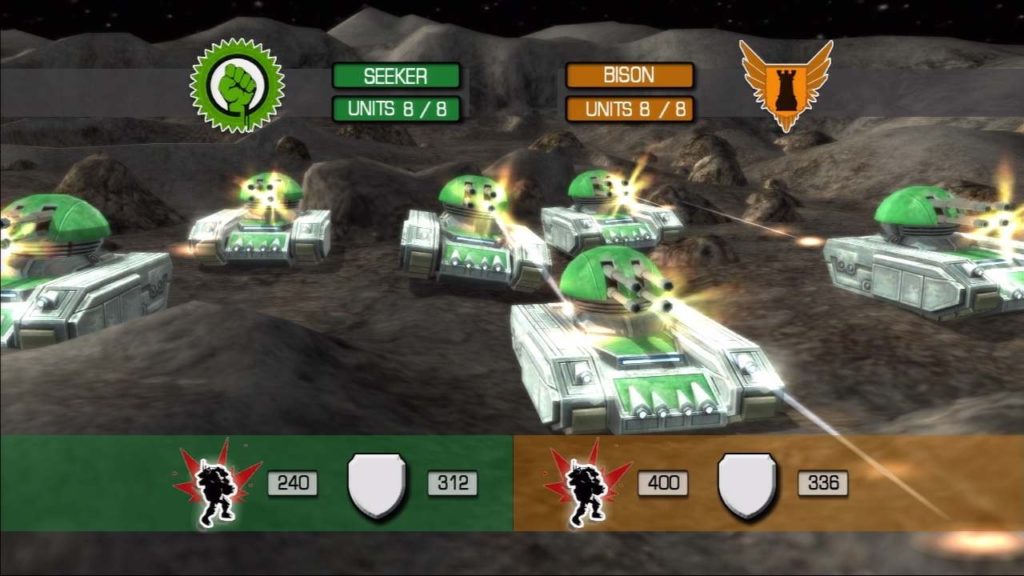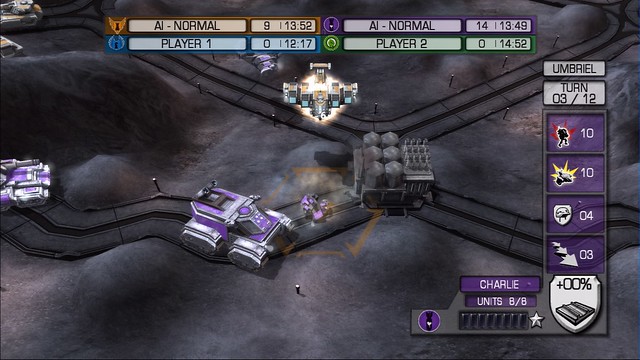If you’ve ever played an Advance Wars game (Gameboy, GBA, DS) or Field Commander (PSP), you’ve a pretty good idea of what to expect from this new Xbox Live Arcade retro remake: turn-based strategy on a hex grid with a military theme. For those new to the genre, don’t be afraid – this isn’t some hardcore sim your father-in-law plays (heya Kevin, totally talking about a different father in-law here, honestly). Instead, this is approachable, manageable strategy without the annoying pressure that realtime games provide (particularly on consoles). Here you have the time to figure out what you should do so, if you lose, don’t go blaming the controls!
Speaking of controls; here the analogue sticks control different aspects of the top-down camera, letting you get a little perspective or pan around the larger maps. The directional-pad is used to switch hexes, letting you see context-sensitive information about what’s on that tile. To move a unit you select it which highlights the different tiles you can move to (tricky terrain can limit the number of tiles you can move in that direction or completely block you, depending on your unit type). Attacking is similar, with tiles you can attack highlighted in red before you move for maximum tactical advantage.

Most units must move before they can attack, however there are some units which can only attack OR move, some that can move, attack and then move again and still others that cannot move without assistance. Fortunately there’s a solid in-game manual to explain the nuances of the combat and it’s well structured and well written, as well as comprehensive. It’s worth diving in to see how you go and then reading the manual – with a little experience under your belt the stuff you read in the help section will make a lot more sense.
Combat comes down to your attack ability and your defensive capability vs those of the oposition. Different unit types will have different strengths and weaknesses so, like Pokemon, choosing which unit you attack with and which units you’re careful to stay out of range of is critical. In addition to the basic attack and defense values of your units, success at combat will be affected by exactly where on the map you are when combat is entered into. If you’re on high ground, for example, your attack ability will be modified vs. if you’re sitting on a road. Sometimes it’s better to wait for the enemy to come to you, so you can hold the terrain advantage whereas othertimes it’s worth throwing yourself into a compromising terrain situation in order to achieve another tactical goal. Therein lies the strategy!
In addition to military units which move around the map, there are various structures available. The most basic of these is your base – you can garrison guys inside here for a significant defensive boost and you’re going to want to look after it because an easy way to win is to get an infantry unit to the enemy base – like Harry Potters golden snitch, this is a game winning maneouvre and losing because the enemy managed to do this while you had a dozen tanks up the front is, well, embarassing.
There are also factories to capture, which don’t behave much like factories modern strategy gamers will be used to. Instead of being used to actually make units (an impossible feat in the world of Military Madness, things just exist – madness!), a factory is where you send your depleted units to be instantly recharged to full “health”. Don’t leave them in there if the enemy is going to capture the factory, though, as they’ll capture everything inside it too.

The AI can be pretty ruthless, routinely obliterating your forces with incredible ease even early on in the proceedings. It’s not always so gung-ho, however, and will occasionally completely fail to attack you for no obvious strategic reason. You can’t win by peaceful negotiation so quite why the computer occasionally skips attacking (sometimes for an entire round) when you’ve got your pants down is a bit of a mystery. Still, human players can be pretty dense too so this almost adds to the realism… It also seems odd that there’s no tactical advantage for being the aggressor in combat, making holding superior terrain and letting the enemy come to you the tactic du-jour.
There’s a bit of a learning curve as you figure out how stuff works and exactly what terrain is advantageous to hold and where you don’t want to enter into combat but the graphics don’t vary much so once you’ve learned it, you’ve learned it and can leverage it in all future encounters. Speaking of the graphics, they can only really be described as utlilitarian. There definitely are more expansive graphics sets around, even in download games but they do the job well enough and better graphics probably wouldn’t expand the audience very much…
Exactly how many people with Xbox 360s are looking for a downloadable remake (that’s remake, not creatively reimagine – this game is basically identical to the original) of a 1989 game for an obscure Japanese console (the TurboGrafx-16, in case you’re wondering) or, in fact, a turn-based strategy game is unclear. To suggest it was a niche within a niche (or a nested niche, to coin a phrase) is probably being kind. That said, if you’re at all interested in playing a strategy game on a console, there’s not many better options – that realtime guff belongs on the PC, turn-based works so much better on a 360 controller. It’s good and definitely worth checking out if you think you might be interested.